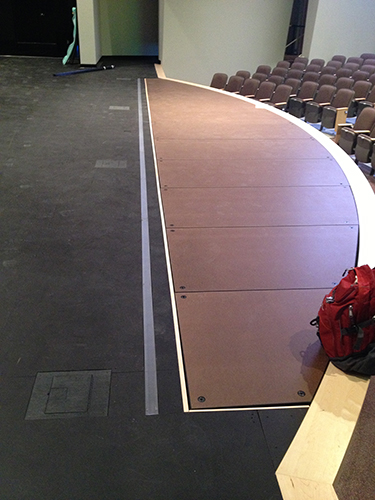|
Subscribe / Renew |
|
|
Contact Us |
|
| ► Subscribe to our Free Weekly Newsletter | |
| home | Welcome, sign in or click here to subscribe. | login |
Construction
| |
 |
August 20, 2015
You can have a safe school theater — even on a budget
PLA Designs

Luntsford
|
It’s no secret that operating budgets for school districts are becoming tighter. As school administrators look for ways to stretch decreasing dollars, many districts have been forced to significantly reduce, or even eliminate technical theater managers/teachers.
For many secondary schools, the drama teacher is actually an English or Western lit major pulling double duty. In some cases, the teacher may have minored in theater at college, but not technical theater.
For most school districts, having a dedicated technical theater expert on staff is an unaffordable luxury. It is certainly possible to merely eliminate all technical theater elements that are inherently risky, resulting in a useless box where no one learns and performances are bland.
A more realistic design goal is to Identify practical, cost-effective design solutions that can help mitigate risk and still deliver the expected level of educational performance.
In April, students at a high school in Westfield, Indiana, were performing the closing number of the musical “American Pie.” Several students were dancing above makeshift decks that had been installed above the orchestra pit when the decking suddenly gave way and 17 students were injured as they fell into the orchestra pit below.
An investigation into the collapse determined that a part-time district employee had removed the orchestra pit covers and supports that were provided when the building was constructed and replaced them with plywood decks of his own design, believing them to be stronger than the original units. A lack of professional knowledge, combined with zeal, resulted in bruises, sprains, a few broken bones and, thankfully, no deaths.
Theater safety is a result of equal parts good design and proper stage management. There are solutions and products available that make proper management of these spaces easier for those without a strong technical theater background.
In order to understand where and how to apply these solutions, one must understand where most accidents or injuries are most likely to occur: stage rigging sets, catwalks, and stage extension platforms.
Stage rigging sets
The most common mishap that happens in educational theater is called a “runaway rigging set.”
First, a quick primer on stage rigging: When you see something move up and down on a stage during a show you are seeing the results of a stage rigging set. A typical stage rigging set consists of a long piece of steel pipe known as a “batten” that is attached by several aircraft cables routed through pulleys to a counterweight “arbor.”
The arbor rides up and down on a series of steel bars. When the arbor goes down, the batten goes up, and vice versa.
Attached to the batten can be scenery, stage lights, electrical distribution, curtains or even large acoustic reflectors. The key is keeping sets in balance.
Whatever the weight of the object attached to the batten, the same amount of weight must be placed on the arbor. This is done by adding steel counterweight “bricks” to the arbor. The arbor is operated by a rope that is captured by what is known as a rope lock. The goal is to have balance so that the rigging set only moves relative to pulling on the rope.
When a rigging set is not in balance, a runaway set can happen. When out of balance, a student disengages the rope lock, allowing the arbor (weighing more than the batten) to come crashing down.
Usually this happens with such force that the arbor bends and the counterweight bricks fly out. Any student near the arbor may be struck by 22-pound bricks of steel.
There is more. Now, the arbor weighs much less and the batten is heavy in the air. Thus, the batten and attached scenery now crash down to the stage floor and flatten anything below.
The best case result of a runaway set is damage to school property. The worst case is severe injury or even death.
One way to mitigate the risk of a runaway set is to design a system of motorized rigging hoists in place of counterweight sets. Most motorized rigging sets eliminate the need for counterweights, and have controllers that sense loads and automatically shut down when more or less weight than what they are anticipating is detected on their battens.
While it may not be financially viable to motorize every rigging set on a stage, identifying the sets whose loads change often, such as stage electrics or scenery sets, and motorizing those sets is a worthwhile investment. Manufacturers of stage rigging hoists have introduced products specifically suited and priced for educational theater, and whose controls offer levels of protection and user interfaces that are accessible to those without an undergraduate degree in technical theater.
Simply put, no counterweight equals no risk.
Catwalks
Another area where accidents typically happen is the catwalk.
Most building codes exempt lighting catwalks (“platforms”) from having any guards or railings. From a risk manager’s perspective, this is insane.
A common solution offered up for secondary school theater catwalks is to provide an abundance of guards. Unfortunately, this actually aggravates risk since the student must climb over the guards to mount and aim the stage fixtures.
A safe, workable and practical solution involves the use of two guard pipes and a chain segment. While it is still advisable to consider deployment of fall-arrest gear on catwalks, this design solution provides for safety and easy management of stage lighting fixtures.
Stage extension platforms
The stage collapse in Indiana was preceded by another stage collapse in 2014 at Rosary High School in Anaheim, California.
Home- or shop-built decks and pit fillers are highly likely to not incorporate proper structural components and connectors required for the forces that are applied to a stage. Professional, engineered product, properly applied and anchored is the only correct solution — and likely the only solution that a risk insurer will honor.
In addition to good decking, all stage openings should be equipped with a fall-safety net system that complies with ANSI and PLASA standards for stages.
Finally, integration of an embedded actor safety strip light at stage edges will prevent accidental walk-off injuries when the bright lights prevent a clear view of the edge.
Safer theaters
None of these items are budget busters. All of them increase the safety factor in a space being run by amateurs instead of IATSE union stagehands.
Performing arts spaces present risk in order to have the ability to create an artificial reality through properly placed lighting and amazing scenery. Taking the time to think outside of the old ways and to selectively integrate safety-inherent systems makes modern educational theater a success even when capital and operating budget limitations constrain what school districts would prefer to do.
Work with a qualified professional theater consultant early and throughout design to explore what is possible.
K. Paul Luntsford is the president and principal consultant at PLA Designs. He has been a facilities design consultant since 1976 and has served as principal consultant and designer on numerous award-winning local and national projects.
Other Stories:
- Landmark Paul Thiry school reopens to students after 34 years
- New Vancouver high school prepares students for careers in health care
- Students have their say in Seattle school project
- High-tech tools help contractors keep up as school construction booms
- The grass is actually greener for schools that install synthetic turf
- A ‘third place’: where students can be themselves
- Six trends shaping the future of campus design
- Bellevue College will open its first on-campus housing in 2018
- How to make existing schools healthier, more efficient
- How to design schools to prepare kids for careers that don’t exist yet



